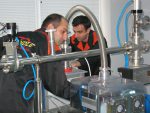Vacuum technology in accelerators
This practical course is aimed at providing basic knowledge of vacuum technique essentials, vacuum measurements, pumping speed, as well as skills for application of vacuum components. The course will cover the basics of preparation and assembly of vacuum components, as well as basic measurements and calculations. During the course, the vacuum level will be measured at different stages of pumping (from coarse to ultra-high vacuum) using different measuring sensors (Thermal resistance vacuum gauge, Bayard-Alpert Pirani vacuum gauge, Invert magnetron vacuum gauge). Based on the curves of change of the vacuum pressure (see Fig.) the pumping speed for each vacuum level and the type of pump (scroll backing pump, turbo-molecular pump, ion pump) to be used will be determined.
The second part of the experimental work is the measurement of vacuum conductance of apertures. In this experiment, the connection of the pump to the vacuum chamber is made through apertures of different diameters. Apertures with 100% of nominal (corresponding to the inlet of the pump), 50% of nominal, and 10% of nominal are used. For each aperture size the pumping of the vacuum chamber is made to obtain a maximum level of vacuum, which corresponds to the capabilities of the pump. Vacuum level measurements are made for each aperture throughout the pumping process. Based on the curves of vacuum pressure change (see Fig.) the pumping speed for each aperture will be determined. According to the results of calculations, it will be necessary to obtain an analytical dependence of the pumping speed ( on the aperture diameter.

